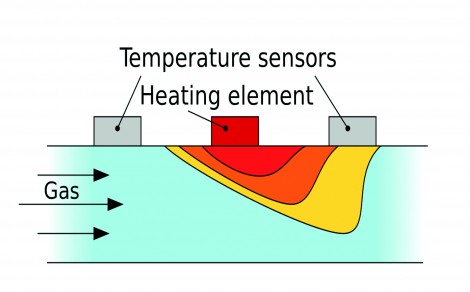Managing losses in compressed air systems with thermal mass flow technology

Monitoring compressed air usage within industrial applications has become increasingly important as the associated costs continue to rise dramatically.
Compressed air systems are often the largest excess user of electricity for a business, with air leaks or poorly performing components contributing to a significant amount of wasted energy. In this age of energy efficiency to ensure a greener footprint, it is becoming more important for all businesses to identify and rectify any potential energy wastage situations. Problem areas in compressed air systems can be identified by fitting thermal mass flow meters, strategically positioned to calculate outflow generated air with downstream usage.
There are several traditional ways of measuring the flow of compressed air in a system, using orifice plates and turbine or vortex meters for example, which will measure the ‘actual' uncompensated volumetric flow of air. However, it is often more important to have a corrected flow rate linked to a particular pressure and temperature at ‘Normal conditions'. This requires a multi-variable solution which can be expensive to buy and maintain and may also increase the chance of errors considering the extra sensors required.
Thermal mass flow meters are an ideal solution for compressed air measurements as they measure the mass flow of the air directly, removing any need to monitor the pressure and temperature separately. Compressed air thermal mass flow meters are effective tools for monitoring and managing energy consumption. According to Bell Flow Systems, they can detect leakages much faster than a pressure sensor, they can be used for cost allocation and they can be used for efficiency monitoring and maintenance management.
What is thermal mass?
In the Thermal Mass Principle image shown, Bell Flow Systems’ MEMS (CMOS) type Thermal Mass flow meter senses flow via the convective heat transfer flow measurement principle. A micro-heater is placed in the middle of two temperature sensors symmetrically positioned at upstream and downstream points. The cavity below the micro-heater and sensors plays the role of thermal isolation as it is filled with the gas. When the flow passes through the micro-heater, heat is carried away by the flowing medium, with the temperature differences measured by the up and down-stream temperature sensors being directly proportional to the mass flow of the compressed air or gas being measured.
Why thermal mass?
There are many advantages to this method of air flow measurement. These types of sensors feature zero moving parts in a nearly unobstructed straight through flow path, which facilitates extremely low pressure drop measurement. Maintenance costs are low and this type of meter is very sensitive at low flow rates, which allows for a high turn-down ratio whilst remaining accurate over a wide measuring range. Insertion style models can also be used in larger pipe sizes, with the option to install via a Hot-tap kit under full system pressure. We recommend placing thermal mass flow meters in dry air downstream of all air treatment filters to prevent sensor degradation. If temperature changes rapidly, this can affect the accuracy of the flow meter and can shorten its service lifetime as well. Large temperature variations, which can be found downstream of malfunctioning desiccant dryers, should be avoided
-
PPMA 2025
23 September, 2025, 9:30 - 25 September, 2025, 16:00
NEC, Birmingham UK -
Advanced Engineering Show 2025
29 October, 2025, 9:00 - 30 October, 2025, 16:00
NEC, Birmingham UK










